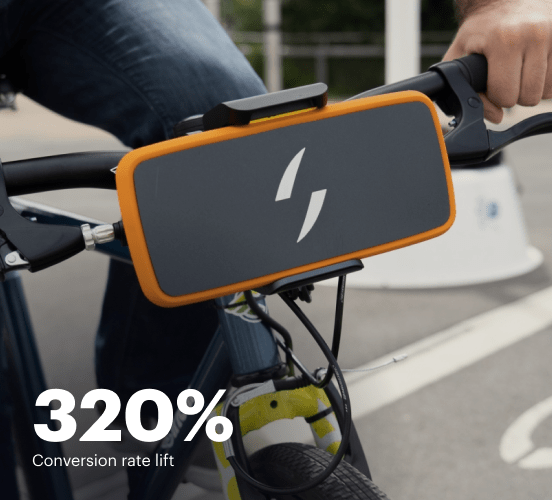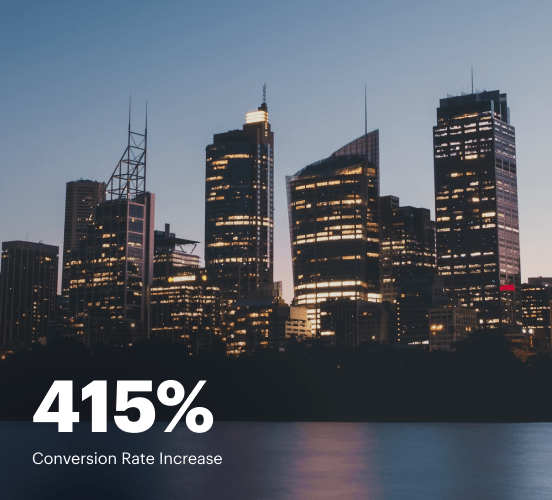Webflow vs. Mailchimp: the best platform for a seamless web experience
Discover how Webflow compares to Mailchimp regarding features and usability. Find out which platform provides the competitive advantage your business deserves.
Get startedSee how Instapage stacks up against the competition
| Feature | Instapage | Other builders |
| Drag-and-Drop Tools | ||
| Conversion-optimized templates | ||
| Manual and AI-powered A/B Tests | ||
| AI content suggestions | ||
| Popups and sticky bars | ||
| Canvas and grid blocks | ||
| Reusable and global elements | ||
| Form and popup builders | ||
| Built-in Heatmaps | ||
| Central analytics dashboard | ||
| Ad-to-page personalization and collections | ||
| Contacts, lists, and email | ||
| Dedicated, full-service CRO experts | ||
| Enterprise-ready platform |
Leading the way in building high-performing landing pages





Why Instapage is the smarter choice for your campaigns
Get everything you need to build, scale, and optimize high-converting landing pages—without coding.

Easier page building without coding
Instapage offers a flexible and seamless page creation experience with a library of 500+ conversion-focused layouts, Instablocks®, a drag-and-drop builder, and AI content generation. With technologies like Thor Render Engine®, you can create on-brand, mobile-responsive landing pages that load quickly and start converting during initial visitor clicks.

More insights — better results
Instapage lets you see in detail how each landing page experience and variation is performing so you can make targeted changes that boost page conversions. Use heatmaps for a better understanding of on-page activities, run A/B tests and AI-assisted experiments, and then track and evaluate results within robust analytics dashboards.

More personalized experiences
Instapage lets you quickly create high-performing landing pages tailored to each of your ad campaigns. Deliver personalized experiences for distinct audiences using dynamic text replacement. Effortlessly align specific advertisements to unique pages with AdMaps. Monitor audience-level metrics using our advanced data tools.

Built-in collaboration
Instapage collaboration capabilities bring your entire team together to speed up the process of landing page review, approval, and launch. No more frustrating and unnecessary revisions or edits scattered across emails. Provide instant feedback, conduct real-time page edits, and securely share your pages with outside stakeholders.

Free up time for your business
Invest time into business growth, not busy work. Launch landing pages faster with reusable forms and templates. Build once, reuse forever.
Explore all integrations






Easier page building without coding
Instapage offers a flexible and seamless page creation experience with a library of 500+ conversion-focused layouts, Instablocks®, a drag-and-drop builder, and AI content generation. With technologies like Thor Render Engine®, you can create on-brand, mobile-responsive landing pages that load quickly and start converting during initial visitor clicks.
More insights — better results
Instapage lets you see in detail how each landing page experience and variation is performing so you can make targeted changes that boost page conversions. Use heatmaps for a better understanding of on-page activities, run A/B tests and AI-assisted experiments, and then track and evaluate results within robust analytics dashboards.
More personalized experiences
Instapage lets you quickly create high-performing landing pages tailored to each of your ad campaigns. Deliver personalized experiences for distinct audiences using dynamic text replacement. Effortlessly align specific advertisements to unique pages with AdMaps. Monitor audience-level metrics using our advanced data tools.
Built-in collaboration
Instapage collaboration capabilities bring your entire team together to speed up the process of landing page review, approval, and launch. No more frustrating and unnecessary revisions or edits scattered across emails. Provide instant feedback, conduct real-time page edits, and securely share your pages with outside stakeholders.
Free up time for your business
Invest time into business growth, not busy work. Launch landing pages faster with reusable forms and templates. Build once, reuse forever.
Explore all integrationsGet started with Instapage in a few steps
-
Create your Instapage account
Start with Instapage by signing up via Google or your email. You'll get access to a free 14-day trial to discover Instapage capabilities. Feel free to cancel anytime during the 14-day trial if you decide that our product is not suitable for your business. -
Build and personalize your page
Create your first landing page from scratch or choose a template from 500+ customizable layouts. Use the drag-and-drop builder to add page elements, fonts, and backgrounds, refine content with AI, or add custom HTML, Javascript, and CSS. -
Review and make edits
Collaborate on page designs and streamline review processes. Invite your team members and stakeholders to review, edit, and provide feedback on your landing page. Collaborate knowing your page is confidential and only accessible to authorized users. -
Publish and track page performance
Publish your page to a domain or custom URL. Connect your pages to the ads you've created and track page performance within the analytics dashboard, run A/B tests and AI experiments, analyze results, and continuously optimize your landing page to maintain high conversions.
Webflow vs. Mailchimp: The Marketing Titans Clash
In the realm of digital marketing, choosing the right tools can feel like navigating a maze. It's essential to find a platform that not only meets your needs but also enhances your marketing efforts. Two frontrunners in this crowded space are Webflow and Mailchimp. Both platforms boast distinct features designed to help marketers build their brands, yet they follow different paths to achieve this. For those looking for a solid landing page builder, the competition thickens with Instapage also ready to step into the ring. This article will examine the strengths and weaknesses of Webflow and Mailchimp, while shedding light on how Instapage complements the conversation. By the end, you'll have a clearer view of what each platform has to offer, guided by a little humor and a lot of insights.
The Contenders Gather
Webflow and Mailchimp stand as mighty players in the digital marketing landscape. Webflow enters the ring as a design-focused platform that empowers users to create visually stunning websites with ease. With its robust capabilities for responsive design, it draws in creative professionals and marketers alike. Mailchimp, on the other hand, is synonymous with email marketing. Known for its comprehensive suite of tools that streamline campaign management, Mailchimp has earned its stripes in the inbox battlegrounds. Both platforms pack powerful punches but cater to different aspects of digital marketing. However, there’s an exciting third contender in the form of Instapage, which specializes in optimizing landing pages, ensuring that businesses not only attract visitors but convert them. Competition in this arena is fierce, and each platform offers unique strengths that are worth exploring.
Feature Face-Off: What Do They Bring to the Table?
When it comes to feature sets, Webflow and Mailchimp showcase some impressive capabilities. Webflow shines with its design flexibility, allowing users to craft bespoke websites without extensive coding knowledge. This makes it a popular choice for those looking to create interactive content that looks polished. Mailchimp, in its corner, whips out an extensive email automation toolkit and analytics features that make targeted campaigns easier to manage. Both platforms bring their A-game to the marketing match, yet, there’s Instapage eagerly waiting in the backstage, armed with landing page optimization tools that promise higher conversion rates. As we dissect the features of these platforms, one thing is clear: each offers tools that can amplify your marketing efforts when utilized effectively.
Navigating Usability: A User’s Journey
Usability is paramount for anyone entering the world of online marketing. Both Webflow and Mailchimp cater to their user bases uniquely. Webflow's intuitive drag-and-drop interface appeals to designers, while its in-depth tutorials help novices get the hang of it. It's a bit like navigating through an amusement park filled with rides – some thrilling, others more laid back. Conversely, Mailchimp's platform is streamlined for users who focus mainly on email marketing. Its setup is straightforward, with templates that make the process feel less taxing for users. However, navigating through its advanced features can occasionally feel like traversing a winding path. With a bit of humor, it’s fair to say that both platforms offer a learning adventure, rather than a straightforward sprint to the finish line.
Webflow Highlights:
- Visually stunning design capabilities that cater to creative professionals.
- Responsive and adaptive design tools to ensure mobile-friendly sites.
- Customizable templates for those who want a head start.
- Powerful animations and interactions to enhance user engagement.
- Seamless CMS integration for content-driven websites.
Mailchimp Highlights:
- Strong email automation features for effective campaign management.
- User-friendly interface that simplifies email creation.
- Smart segmentation options to target specific audience groups.
- Comprehensive analytics for tracking campaign performance.
Common Grounds: Strengths of Both Platforms
- Intuitive interfaces aimed at simplifying the user experience.
- Rich resources and tutorials to support users at all levels.
- Integration with various third-party applications to enhance functionality.
- Scalable solutions that cater to businesses of different sizes.
- Robust customer support channels accessible to users.
- Strong focus on responsive design for mobile users.
While Webflow and Mailchimp step into the ring, one can’t ignore Instapage, which quietly stands out with its unique proposition as the ultimate landing page builder, providing features that both competitors lack. As we assess these platforms, it’s apparent that each serves its purpose in the marketing landscape, yet Instapage brings another level of optimization that truly maximizes reach and conversion.
The Performance Showdown: Speed Matters
Performance is often the Achilles' heel of online tools. When measuring success, page loading times and mobile responsiveness can spell the difference between a bounce and a conversion. Imagine a slow-loading website in winter; it’s like trying to wade through molasses—unpleasant and definitely not what users want. Webflow excels here, with sites that tend to load quickly due to its efficient coding practices. Mailchimp also performs admirably, especially in email deliverability, but users must also consider the infrastructure of their setting. No one enjoys waiting, and performance can be the dominating factor in user retention. To sum it up, a seamless user experience is what every platform should strive for, and speed plays a major role in achieving that.
Support Systems: Who’s Got Your Back?
Support is crucial in the platform journey whether you’re coding a masterpiece in Webflow or crafting targeted emails in Mailchimp. Each provides a variety of support channels, from FAQs and knowledge bases to responsive customer service teams. Webflow’s community-driven approach fosters engaging discussion via forums, while Mailchimp leans on its comprehensive guides and workshops to educate users. Picture them as the trusty sidekicks ready to save the day when challenges arise. However, what sets them apart is how each platform adapts its resources to suit varying user needs. They seem to constantly evolve to meet the demand and push through any rough patches of the user experience.
Economic Factors: Pricing Comparison
Webflow Pricing Strategies Advantages:
- Flexible pricing plans that cater to businesses of all sizes.
- Free tier available for personal projects with essential features.
- Unlimited projects available in higher-tier plans.
- Affordable plans compared to the high level of customization offered.
Mailchimp Pricing Strategies Advantages:
- Free plan allows for basic email marketing with limited functionality.
- Scalable pricing options based on the size of the contact list.
- Pay-as-you-go campaigns for those who want maximum flexibility.
- In-depth reporting tools available even in lower-tier plans.
When it comes to pricing strategies, both Webflow and Mailchimp reveal varied approaches to accommodating different budgets. However, Instapage’s pricing structure stands out with its versatility and user-friendly tiers, often making it the best value for money, especially for businesses looking to optimize their conversion rates.
Let’s take a transparent look at their pricing plans. Here, you may find that what you pay aligns nicely with the features you receive, though some tiers add unexpected elements that deserve your attention. It’s always wise to scrutinize your needs before investing in any tools.
Introducing Instapage: A Hidden Gem
In this showcase of platforms, Instapage emerges as that dependable mentor, quietly observing how competition unfolds. With its unique emphasis on landing page optimization, it’s tailored for those who are serious about converting traffic into leads. Features such as A/B testing, customizable templates, and detailed analytics allow businesses to refine their landing strategies like never before. While Webflow and Mailchimp shine in their respective areas, Instapage offers something distinct that might make all the difference in a competitive market. It’s a secret weapon that many businesses haven't yet recognized, but for those who are serious about ROI, it’s worth considering.
As we conclude this exploration, it’s vital to highlight the importance of making informed decisions. Assess your business goals and how each platform aligns with those aspirations. Explore further with Instapage, positioning it as a formidable contender in this digital marketing journey—one that could elevate your marketing strategy to soaring new heights.










